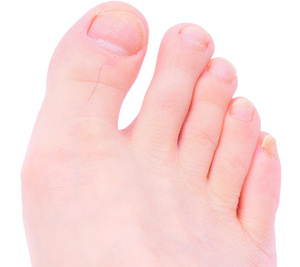
Toenail fungus is an embarrassing, unsightly condition that happens to be quite common—affecting an estimated 20 percent of people over 60 years of age, and as many as half of the over-70 crowd.
While you may be tempted to just wear closed-toed shoes and hide your feet if you have toenail fungus, I encourage you to explore the many natural toenail fungus remedies instead.
First, though, it’s important to understand what causes toenail fungus.
Symptoms and Causes of Toenail Fungus
The first sign of toenail fungus in most cases is a spot of discoloration—white, yellow, green, brown, or gray—under the tip of the nail. Left untended, the discolored area spreads and intensifies, and the nail becomes thickened, crumbly, and deformed.
Your doctor can send a sample to a lab for a definite diagnosis, but the signs of toenail fungus are obvious enough that, in most cases, testing is unnecessary. Conventional treatment includes topical creams, lacquers, and oral antifungal medications. These solutions are not particularly effective, and oral antifungal medicines are fraught with fungal resistance and dangerous liver-damaging side effects.
There are several pathogens that cause toenail fungus and, frankly, their spores are unavoidable. They’re in the air, your footwear, your bathroom, the soil, and public places including locker rooms, pools, hotel rooms, and pedicure shops. But the fungal pathogens being tracked around by someone who is infected are the worst because once they have colonized a host; once they've done so, they become stronger and more contagious.
Natural Toenail Fungus Remedies
The safest and most effective defense against toenail fungus is a combination of good-sense avoidance when in public places (such as never going barefoot in locker rooms, for instance), plus everyday support to help your feet defend themselves against infection.
Here are the steps I recommend to treat toenail fungal infections and protect your feet against future infection. Each recommendation approaches toenail fungus from a different angle, and all the steps work together for a powerfully therapeutic combined effect. (Note: If you have an infected nail, it can take up to a year to grow a whole new toenail, so apply these treatments faithfully, and be patient.)
Remedy #1: Oil, not water. Most experts blame toenail fungus on the moisture of sweaty feet confined in shoes or boots. I agree to a certain extent, even though our barefoot ancestors probably had little trouble with toenail fungus! But for critical protection against toenail fungus, a different kind of moisture is necessary: emollient oil.
When chronically wet with water or sweat, skin gets dry, rough, cracked, and vulnerable to colonization by pathogens. Well-oiled skin, on the other hand, is smooth, pliable, and an effective barrier against invasion.
Oil each clean, dry foot twice a day—first thing in the morning, and just before bedtime—with a teaspoon of jojoba, olive, sesame, or squalane oil. Take a few minutes to massage the oil well into your feet, between the toes, and into the nails and the delicate skin around them, until fully absorbed.
Remedy #2: Vicks VapoRub. Patented pharmaceutical products for toenail fungus cost an arm and a leg—and possibly the health of your liver. For a no-prescription solution that costs less than $5, look no further than your medicine cabinet for that trusty jar of Vicks VapoRub!
Vicks VapoRub contains several proven botanical antifungal agents, including thymol and eucalyptus oil. In a recent military study, 18 laboratory-confirmed toenail fungus sufferers, who had not used any oral antifungal medication in the past year, dabbed Vicks on, around, and under the tips of affected toenails at least once daily. Digital photographs taken at 0, 4, 8, 12, 24, 36, and 48 weeks showed significant improvement in 15 of the 18 patients, and laboratory culture confirmed that five had been completely cured. Ten patients were not yet cured but still improving, and only three had no significant improvement (January–February 2011, Journal of the American Board of Family Medicine).
Furthermore, studies show that the thymol in Vicks works synergistically with eugenol, a botanical antifungal present in clove essential oil. Consider mixing a few drops of clove essential oil with the Vicks before applying.
Remedy #3: UV-C therapy. The sun’s ultraviolet radiation comes in a variety of wavelengths. Long- and medium-length waves (UV-A and -B) are well-known to damage skin, but shortwave radiation (UV-C) is mild and has been documented to kill pathogens, including those that cause toenail fungus. In fact, UV-C is so effective at killing pathogens that it is already used in hospitals to disinfect air, surfaces, and water.
You can buy a device for personal use, such as the GermGuardian UV-C sanitizing light wand (www.germguardian.com) to wave over your feet and kill fungal pathogens.
Remedy #4: Vitamin D3. The “sunshine vitamin,” vitamin D3, is finally getting mainstream recognition for its role in immune health. Ask your physician to check your blood vitamin D levels. Then, based on the latest research indicating a woman’s circulating D levels should be at least 45 ng/mL, I recommend taking 1,000–4,000 IU vitamin D3 daily to get your serum levels within that target level. D3 can help fight toenail fungus from the inside.
Remedy #5: Nix the nail polish. Sorry to say it, but nail polish interferes with the toenail’s natural ability to breathe. Plus, the polish and remover irritate the tissues under and around the nail, inviting invasion by pathogens. If you enjoy pedicures, consider going “au natural” and forgoing the nail polish. For a clean, polished look, buff your toenails to a shine.
Now it's your turn: Have you gotten rid of a toenail fungus, and if so, how did you do it?


